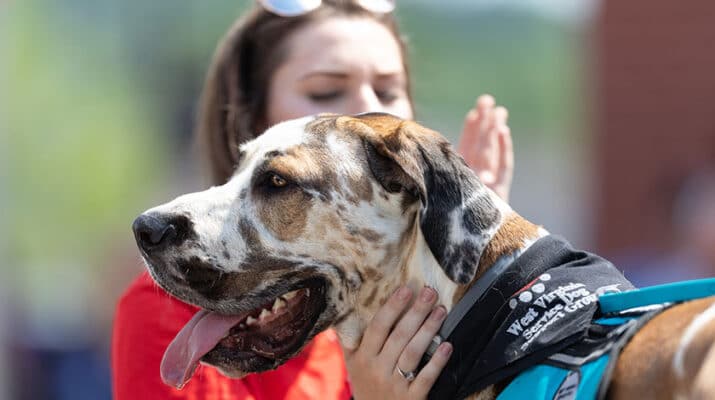‘Man’s best friend’ is much more than just a family pet
By Deborah Jeanne Sergeant
Assistance dogs can perform more tasks than guiding. Their role has expanded considerably to provide help for a variety of needs, including helping people with autism.
Veronica Federiconi, CEO of Autism Services, Inc., in Amherst, said that service dogs trained to help children with autism may be used for helping them transition from one place to another.
“The dog is familiar to the child and makes it a little easier,” she said.
Since 60% of children with autism have other, unrelated neurological conditions, service dogs can be trained to assist with other tasks such as sensing seizures so the child can lie down in a safe place and minimize the risk of injury or altering diabetic emergencies.
“Primarily, we use dogs for detecting if the child is going to have a seizure,” Federiconi said. “Others are for navigating and keeping them safe. Safety is a huge reason to have a dog.”
While pet dogs can offer emotional comfort to people of any ability, service dogs that help a child with autism can do that and so much more. It is not a matter of finding a nice puppy or even a well-mannered adult dog.
“You really need to go to someone that can provide an animal that is highly trained for this,” said Kathy Eiss, president of the Autism Society of Western New York in Buffalo.
A therapy dog and a service dog have different levels of access to public spaces. Therapy dogs are trained and can be certified to aid in providing comfort and emotional support. Service dogs, including those trained to assist children with autism, are protected under the Americans with Disabilities Act to go with their child and handler to any publicly accessible place. Service dogs can also provide emotional support but are also trained and certified in specific tasks to help mitigate the effects of a disability.
Katy Ostroff, licensed clinical social worker and manager of client services for NEADS World Class Service Dogs in Princeton, Massachusetts, said that her organization trains yellow and black Labradors as autism service dogs for children aged 8-16. Their training is at the same level as any other service dog, only with skills that can help someone with autism. The organization ordinarily places 50 dogs annually and has placed more than 1,900 since its founding in 1976.
“The dogs are trained with the parent to help the child mitigate the symptoms of autism,” Ostroff said. “We find for many of our children who apply, there’s a concurrent diagnosis of anxiety, depression, obsessive compulsive disorder, or Tourette’s. The work that the dog does with the parent is all about helping the child regulate emotions.”
The dog’s “tools” may include providing gentle pressure by lying across the child’s lap, which some autistic children find soothing and can help lessen meltdowns. By minimizing the number and extent of meltdowns, families can feel freer to go places and spend time in public with their children. The dogs can perform tasks like alerting parents of non-verbal children when they need help.
“We had many instances where kids were petrified of the dentist, the doctor or a restaurant that is too loud,” Ostroff said. “The dog gives them a focal point, reliability and consistency.”
In addition, service dogs perform helpful tasks that are not trained, such as providing a social bridge for children who typically feel left out and stigmatized because of their differences. Typical children spot the service dog and gravitate towards the child with autism. These interactions can help foster friendships — something that can challenge children with autism.
“We’ve found the dog is a great tool for socialization,” Ostroff said. “It’s easy to memorize the dog’s name, weight, birthdate and easy commands.”
Many children with autism struggle with learning how to make eye contact and understand facial expressions. Service dogs offer a nonjudgmental individual to practice on. Ostroff said that the dogs are trained to give children eye contact and that transfers to relating better to people.
NEADS raises purpose-bred dogs and uses puppy raisers as foster homes to provide socialization and basic obedience training, followed by training on their campus. Before the pandemic, the organization also worked with a prison-based program that involves inmates training dogs. These dogs go home with foster families on weekends for additional socializing.
Those potentially receiving a dog are carefully screened, first by Skype and then in-person at the NEADS campus before beginning the process of matching a dog to the family. The dogs must show aptitude for the tasks and for working with children. Those who do not “make the cut” are available for other service jobs for which they might show aptitude or for adoption as family pets.

